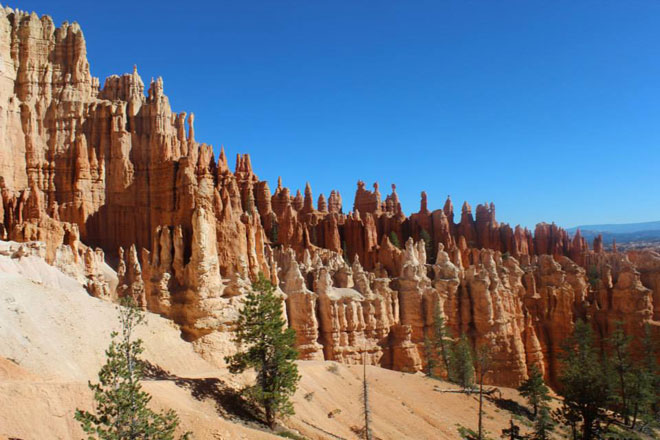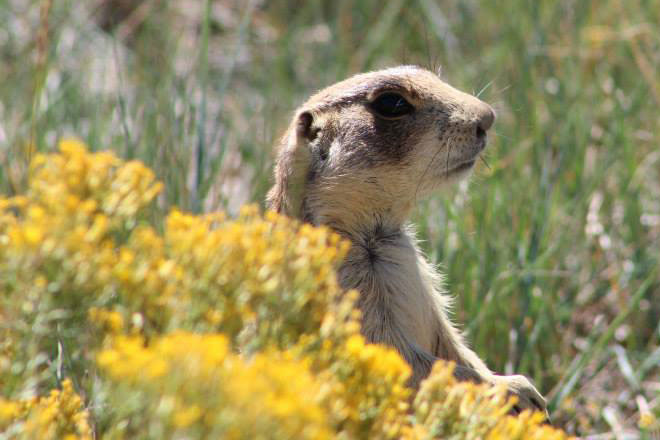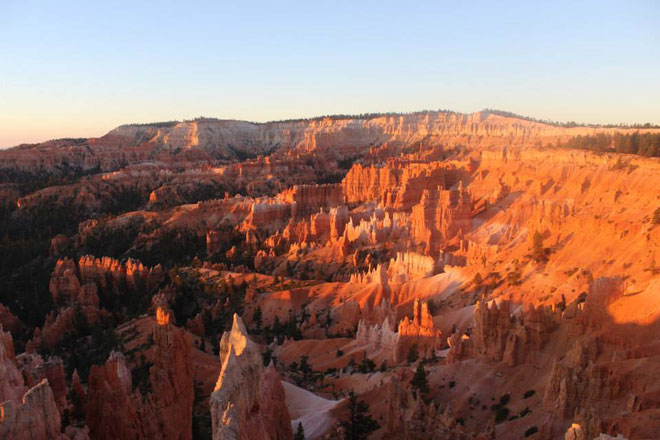What do these things have in common: Fairyland, Peek-A-Boo, Queens Garden, and Hat Shop? They are all names of fun trails to hike at Bryce Canyon National Park.
If there is one thing Bryce Canyon is best-known for, however, it’s hoodoos. Bryce Canyon is full of these amazing pillars formed by erosion and a process called “frost wedging,” where water repeatedly freezes and melts. This causes the rock to crack and break, creating balanced rock formations, windows, fins and cave-like features along the canyon walls. The effect is bewildering. The colors, shapes, and shadows change with the sun, providing different perspectives of the hoodoo valley and pillars.
Did you know? Bryce Canyon isn’t actually a canyon. Canyons and natural bridges are formed by running water like rivers and streams. Arches, hoodoos, and windows are formed by rain, erosion, and frost wedging. Bryce is actually a bunch of amphitheaters filled with limestone hoodoos. Though Bryce Canyon is small compared with other national parks, there is still plenty to do.
Highlights
Fun Fact
Bryce Canyon National Park is named after Mormon pioneer Ebenezer Bryce. Ebenezer and his family first arrived in Clifton in 1875, where he created a seven-mile irrigation ditch and built a road into the cliffs to better access timber. People started calling the amphitheater where the road ended “Bryce’s Canyon.”
Visitor Center. The visitor centers in our national parks are always a smart first stop. Drop in and speak with a ranger about potential activities, check out displays and event schedules, learn more about the history of the park, or even buy a souvenir. This is always a great place to stop and plan your day. Also check with rangers on weather conditions if you plan to hike—flash flooding and lightning can be very dangerous in this area.
Shuttle. Bryce Canyon offers voluntary shuttles that run from May through October. They stop at all major overlooks and are completely accessible. Shuttles help reduce congestion in the park. The route begins just outside the park near ample parking.
Utah prairie dogs. As you approach the left turn to Bryce Canyon Lodge, there is a field to your right and a road that leads to employee lodging. This field isn’t an ordinary field, but one full of Utah prairie dogs. At the turn of the 20th century, nearly 100,000 of these animals existed in the West, down from an estimated 5 billion at the time the region was being settled. Today there are fewer than 7,000, due largely to intentional pest-control programs started in the 1920s that poisoned much of the population, putting the prairie dogs on the threatened species list. See them here before heading out to hike and sightsee.
Overlooks. Bryce Canyon offers 14 major overlooks, all of which provide dazzling views of the amphitheaters and valleys below. Be sure to take the drive out to Rainbow Point along a wonderful road surrounded by forest. The total elevation change at the park is 2,000 feet, creating an extremely biodiverse habitat for plants and animals. You never know what you might see.
Hiking. Checking out the overlooks is nice, but seeing these hoodoos up close is a whole other experience. Bryce Canyon’s trails lead you into the heart of the amphitheaters, allowing you to see these colorful pillars up close and personal. Peek-a-Boo Loop and Fairyland are two must-see hikes to add to the list. Be sure to wear hiking boots with good traction and ankle support, as hiking with the wrong footwear is the number one cause of rescues and injuries at Bryce.
- Sunrise. Seeing the sun rise over the hoodoos is a magical experience. Be sure to get to Sunrise Point early to claim your spot, then sit back and enjoy as the sun begins to peek over the horizon and the light crawls down the cliff side, illuminating the pinks, oranges, whites, and reds. The higher the sun rises, the brighter these colors become. Be sure to bundle up; it can be quite chilly in the morning.
Tip: Be sure to bring long sleeves, rain coat, and a hat. The weather in this area can fluctuate without warning. Temperatures can change as much as 40 degrees F from sunrise to sunset.
This story is part of NPCA’s biweekly Desert Getaway series. Read more stories in the series for tips on visiting other desert parks.
About the author
-
 Megan Cantrell Former Social Media Manager
Megan Cantrell Former Social Media ManagerMegan Cantrell worked at National Parks Conservation Association for 10 years, much of that time shepherding NPCA’s social media program.
-
General
-
- NPCA Region:
- Southwest


